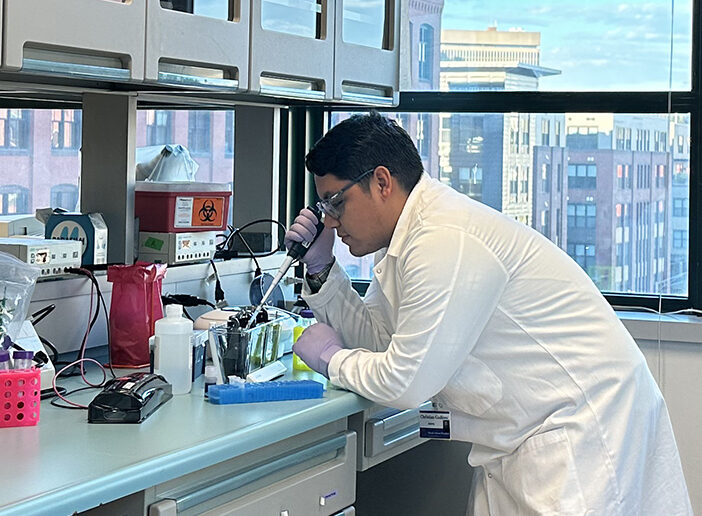Summer academy in neurology and neurosurgery opens doors for high school students.
For students who want to study the brain and nervous system, researchers like Christian Godinez know that real-world experience is crucial to success. It’s why his participation in the Research and Clinical Exposure to Neurology and Neurosurgery summer pathway program last year continues to pay dividends beyond his classroom experiences.
The free, two-week summer program gives students of historically underrepresented groups and economically disadvantaged backgrounds from the University of Rhode Island a new perspective on the clinical and research aspects of both fields. Students immerse themselves in clinical spaces, where they have one-on-one interactions with physicians, researchers, and patients, and use project-based exploration. They’re also paid a stipend upon completion.
Godinez, who finished the program alongside two other students during the 2023-2024 academic year, says it was a natural fit for his career aspirations. Godinez pursued neuro-related studies not only out of his own burgeoning interest, but also because of the loss of a family friend, who was like a “second mother,” to glioblastoma in 2020, just as Godinez began his freshman year at URI. He graduated in May with a BS in cellular and molecular neuroscience.
“I wanted to be part of the research and efforts behind finding some sort of therapies for cancer related to the brain or the spinal cord,” Godinez says.
Luckson Omoaregba, MS, director of Pathway Programs at The Warren Alpert Medical School, says R-CEINN was borne from discussions with Neishay Ayub MD’14 RES’15, assistant professor of neurology and the department’s diversity, equity, and inclusion officer; Deus Cielo MD’96, assistant professor of neurosurgery and vice-chair for DEI; and Tina Burton, MD, assistant professor of neurology. Omoaregba says the group focused on how best to implement a program that could introduce high school students or undergraduates to fundamental concepts in neuroscience. From the beginning they focused on workforce diversity, and particularly on students from historically underrepresented groups, within their respective fields, Omoaregba says. He also counts former neurosurgery resident Matthew Anderson, M.D. RES’23 as another key figure in jumpstarting the program.
The initial plan for R-CEINN grew from hosting students for a few weeks into recruiting students for a two-week clinical experience followed by a semester-long research program, funded by the Pappito Opportunity Connection. Students get a firsthand inpatient and outpatient experiences in neurology and neurosurgery, work alongside attendings and residents, and participate in career development workshops. All three students continued their summer projects into the following academic year.
Ayub says the program supports students’ independence by encouraging them to select their research mentors and co-design a research project of their own.
“We also want to make sure they’re excited about working with their mentors and are passionate about their projects,” she says. “We also hope to maintain longitudinal relationships with the students so we can help in their path to science beyond their time in the program with us.”
For example, a program graduate like Godinez could easily move into labs and hit the ground running with new and existing research, much like he did with Patricia Leigh Zadnik Sullivan, MD, and Margot Martinez Moreno, PhD, director and co-director, respectively, of the Center for Spine Tumor and Chordoma Research. Sullivan says they help students get a handle on the basics of laboratory work like RNA extraction techniques.
“The goal of the semester was not to have a written output, but we want to make sure they have an abstract or manuscript they’re submitting,” says Sullivan, an assistant professor of neurosurgery. In Godinez’s case, he submitted an abstract to the Legoretta Cancer Center.
That focus on producing deliverables is an important benefit for students, but Sullivan emphasizes that, with about 20 students working on projects and bringing unique perspectives, there are clear benefits for Brown’s labs as well.
“I don’t think I could do what I do if we didn’t have full-time students working with us,” she says. “It allows me to focus more on grant writing, supervising, and directing the output of each project. With every new, full-time staff member we hire, we’re able to mentor additional students who are learning techniques [R-CEINN participants] have mastered. It’s kind of a trickle-down effect.”
Sullivan praises Godinez and his peers for hard work, and for prioritizing some of the “rigorous protocols” with the lab work.
“[Godinez] follows all of that to the letter of the law. You can’t really teach that respect for science—he brought it with him,” Sullivan says.
After graduation, Godinez stayed on in Sullivan’s lab as a research assistant. While he’d had some lab experience at URI, like cell culture experiments and running qPCR (which measures DNA using polymerase chain reactions), Godinez says Sullivan, Moreno, and their staff gave him tangible skills alongside the confidence to continue his path.
“For the other students to share their knowledge and talk so openly about their experiences was amazing,” he says. “Some of them were saying, ‘We’ll see you in a few years.’”
Providing students of marginalized backgrounds with a unique program has been rewarding for Sullivan and Ayub.
“What we try to do is create an environment that takes away things like the financial strains and stresses that are barriers to accessing science and academia,” Sullivan says. “I think once you lower those barriers, you would be amazed at how the diversity naturally grows.”
“The program is unique because of the combination of all the different experiences, so it’s a more holistic experience for students,” Ayub adds. “We want them to complete research projects, yes, but we want them to know why they’re doing it. We want them to see the actual patients who benefit from the research they do and how the real-world differs from the textbook. Medicine is as much an art as it is a science, and we want them to see all aspects of it.”




